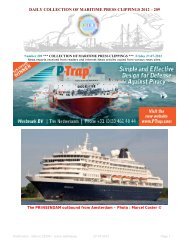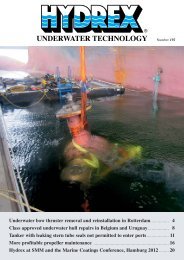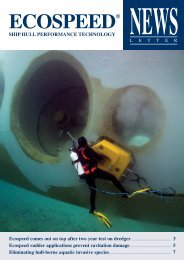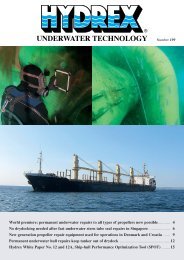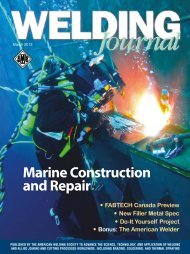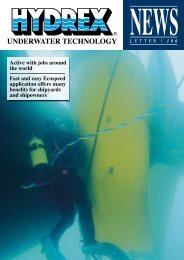Navios Sagittarius - Hydrex Underwater Technology
Navios Sagittarius - Hydrex Underwater Technology
Navios Sagittarius - Hydrex Underwater Technology
You also want an ePaper? Increase the reach of your titles
YUMPU automatically turns print PDFs into web optimized ePapers that Google loves.
Construction of the two frames which were welded to the hull over the two main areas of damage and used as a template sothat accurate measurements could be taken and used for design and fabrication.Mr. Chourdakis manages C. N. Zachopoulos& Associates Ltd., Piraeusbased Marine Surveyors and ConsultantEngineers, and also serves asTechnical Consultant for Tsavliris,overseeing technical matters regardingthe company’s fleet of tugs andalso as naval architect in salvage operationswhere required. In this caseMr. Chourdakis worked on and oversawall the necessary planning andengineering which went into repairingthe two major damaged areas of theship.When asked if there were any particularchallenges in the <strong>Navios</strong><strong>Sagittarius</strong> underwater repair, Mr.Chourdakis explained, “The extendeddeformed area and local damages(cracks and fractures) caused by thismajor grounding, in combinationwith the marginal reserve of remaininglocal and longitudinal strength,necessitated accurate calculationsand detailed step by step planning tocope with safe repair requirements.Various other parameters such as thenecessity of shifting cargo during therepairs, the vessel’s list, the weatherconditions and the working depthrequired made it vital to have goodorganization and management of allparties involved and good teamwork.”“Formation in 3D of a large steel plateto exactly match the shape of thedeformed and fractured bottom platerequired accurate measurements fromthe divers and analytical calculationsfrom naval architects,” he continues.“Finally, cutting the heavily deformedhull area and fitting of a large, newpre-fabricated section following thevessel’s original drawings and makingit resistant and watertight was the topchallenge.”The repair was a combination of accurateengineering and precise cutting,7
Fast and high qualityin-situ repair servicesin theWesternMediterranean areaand North AfricaThe <strong>Hydrex</strong> office in Algecirasis ready to mobilizeimmediately with their twodedicated dive support vessels.Both vessels are fully equippedas service stations for a widerange of repair operations andallow for a fast response in thebay of Algeciras, Gibraltar andNorth African ports.As part of the <strong>Hydrex</strong> group,<strong>Hydrex</strong> Spain takes advantage ofthe companies’ 37 years of experience.All operations are carriedout by highly certified diver/technicians all of which havebeen trained in the headquartersin Antwerp and have extensiveexperience, enabling the officeto offer their customers the highquality <strong>Hydrex</strong> is known for.fitting, assembly and final welding,and the coordination between thenaval architects and the divers/techniciansimplementing their plans wasclose and continuous. Professionalismon the part of the individuals andgroups involved, coupled with excellentteamwork contributed largely tothe success of the entire operation.Planning and fabricationWithout accurate measurements anddata, the naval architects could notproduce drawings and plans whichwould work. So the first step was toget accurate measurements for the twomajor areas of damage (one near theforepeak, the other further aft, both onthe port side), on a hull that was badlydeformed, pierced, torn and indented.In order to do this, the <strong>Hydrex</strong> teamconstructed large frames on the deckand then lowered these into the waterand secured them in place over thetwo large damaged areas. These werethen used as a reference so thatmeasurements could be taken andrelayed to the naval architects. TheThe repair was a combination of accurate engineering andprecise cutting, fitting, assembly and final welding, and thecoordination between the naval architects and the divers/techniciansimplementing their plans was close and continuous.frame for measuring the 8 x 1.8 mdamaged area was subsequently alsoused in the fabrication of the doublerplate itself.Using these measurements and theoriginal drawings of the ship, thenaval architects were then able toproduce final drawings from which asection and a doubler plate could befabricated and installed.Jobs recently carried out by<strong>Hydrex</strong> Spain include a propellermodification, pipe repairs, rudderrepairs and stern tube seal repairsin Algeciras, propeller modificationsin Cadiz and an azimuthbow thruster removal and reinstallationon a pipe laying vesselin Cartagena.<strong>Hydrex</strong> SpainPoligono Industrial Palmones IICalle Dragaminas Nave N2911370 Algeciras • SpainPhone: +34 956 675 049 (24/7)Fax: +34 956 921 914E-mail: info@hydrex.esExamples of 3D drawings produced by the naval architects and used in fabricationand installation of the hull section (left) and doubler plate (right) whichcomprised the repair of the two major areas of damage to the hull.8
The finished section being lowered into the water and inserted into the cut-out in the hull using chain blocks.The section was built with a hatch atthe bottom so that divers could enterthe section from the outside andweld inside. When the section was allsecured in place, the hatch itself waswelded shut.Originally it was thought that thesection would then be welded in placeall the way around but due to thedifficulty of taking precise measurements,the distortion of the hulland the gaps resulting when thesection was in place, it was decidedto have the section bolted in placewith a seal to ensure a watertightfit and then welded from the inside.This solution worked very well.The hatch built into the bottom of the hull section to provide access to divers sothat they could work inside to secure the section.10
The quality of the wet welding was ofthe standard required. This was importantbecause when the wet weldingwas finished and the water could bepumped out, a surveyor, the navalarchitects and the owner came insideto inspect, and the surveyor was ableto confirm to the naval architects thatthe wet welds were satisfactory andacceptable. Had the welding not beenup to standards, it would have beennecessary to go over all the welds onthe inside of the hull and dry weldover all the seams, which would haveadded a great deal of time to the job.This meant that the team working onthe inside of the hull could concentrateon the other repairs needed tofix the section in place and make thevessel seaworthy.Construction and preparation of the doubler plate used to repair the long8 x 1.8 m tear in the hull near the forepeak.12
Preparing and lowering the doubler plate into the water so that it could be welded in place to repair the 8 x 1.8 m rip in thehull near the forepeak.COLD STRAIGHTENING OF SEVERELYBENT PROPELLER BLADESIn its quest to provide costeffective services to customers,<strong>Hydrex</strong> developed procedures toaddress different kinds of damageto propellers. This research ledto the design of the <strong>Hydrex</strong> coldstraightening machines first usedin 2002.By taking advantage of this techniquedamaged blades can be straightenedunderwater, allowing the shipto return to commercial operationswithout the need to drydock. Bladescan be brought back close to theiroriginal form, restoring the propeller’soptimum efficiency.The cold straightening machineshave been in use for quite sometime now but the <strong>Hydrex</strong> researchdepartment has been looking intoways to expand the technique evenfurther to improve our services. A newversion of the straightening machinewas recently put into practice. It iscompatible with the existing modelsand is used to restore more severelybent propeller blades to their originalcondition.13
The successful manning of a 24-manteam, mobilization, equipment, andexecution of the work on a projectof this size can only be undertaken bya large, well trained and experiencedcompany. <strong>Hydrex</strong> was also runninga large similar operation in Fujairahin association with Mr. Chourdakis(Tsavliris), along with several smallerprojects overlapping the <strong>Navios</strong><strong>Sagittarius</strong> salvage operation andamounting in total to an additional24 diver/technicians performingoperations around the world. OnnoDe Nooijer explains that there werechallenges for <strong>Hydrex</strong> to overcome inthe initial manning and organizingof the teams and ensuring that thevarious skills needed were adequatelyrepresented, but this was ironed outand for the majority of the projectthere was a very stable and highlyskilled team of divers/technicianswith the right skill set and all workingtogether. Mr. Michalis Chourdakissaid of the team, “<strong>Hydrex</strong>’s technicalabilities and competence are wellabove average of other big companiesfor underwater work.” The <strong>Hydrex</strong>personnel were, in their turn, veryimpressed with the work and supportof Tasvliris, the salvage master, andthe professionalism of the naval architectteam.The naval architects under Mr.Chourdakis surmounted the engineeringdifficulties created largely bythe severely weakened hull and theproblems of measurement and executionunder poor weather conditions,and their planning and its executionsolved the ship’s problems so that shewas able to sail to China via the Capeof Good Hope without having tooffload all of her cargo or go into drydockat a nearer port for repairs, atestimony to their skill.The professional fabrication and constructionservices of the Frederikshavendockyard were employed inbuilding the section and the doublerplate, both of which worked admirablywhen installed. Crane operators,workboat crew, the Danish naval command,the Danish environmental authorities,the classification societysurveyors all played their different andvital roles in executing the salvage.The extensive know-how and experiencein salvage operations of theTsavliris Group, represented on site bysalvage master, Mr. Barend Visserwith his experience, credentials andmanagerial efficiency, were brought tobear in coordinating and overseeingthe entire project and bringing it to aThe successful manning of a 24-man team, mobilization,equipment, and execution of the work on a project of thissize can only be undertaken by a large, well trained andexperienced company.successful conclusion under demandingcircumstances with more than satisfactoryregard for the ship’s schedule, theprotection of the environment and thesafe management of the divers.Few salvage companies in the worldhave the personnel, know-how, equipmentand experience to successfullymanage a salvage operation of thisnature and few underwater repaircompanies have the specialized personnel,equipment, expertise and skillto execute the needed repairs.It is, as far as we know, the first timethat an entire hull section has beenprefabricated and inserted into a ship’shull, cutting away the existing damagedplates, with the ship still afloat,thus permitting the vessel to continueon a major voyage without the need todrydock.CLASS ACCEPTEDUNDERWATERSTERN TUBE SEALREPAIRS UNDERWARRANTYUsing our flexible mobdockmethod to create a dry underwaterenvironment, we havecarried out stern tube sealrepairs and replacements underwaterfor some years now incooperation with top specialistsuppliers.This technology brings drydockconditions to the ship rather thanhaving to take the ship to drydock,saving a considerable amount oftime and money in doing so.This class accepted method is performedby our diving teams underour warranty. It can be used whilethe ship is carrying out its usualcargo or other commercial operationsin port.Visit the special stern tube sealrepair section on our website formore information and examplesof the many seal repairs we haveperformed in recent years.15



